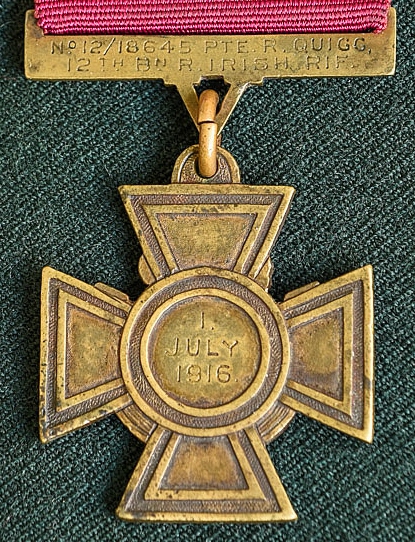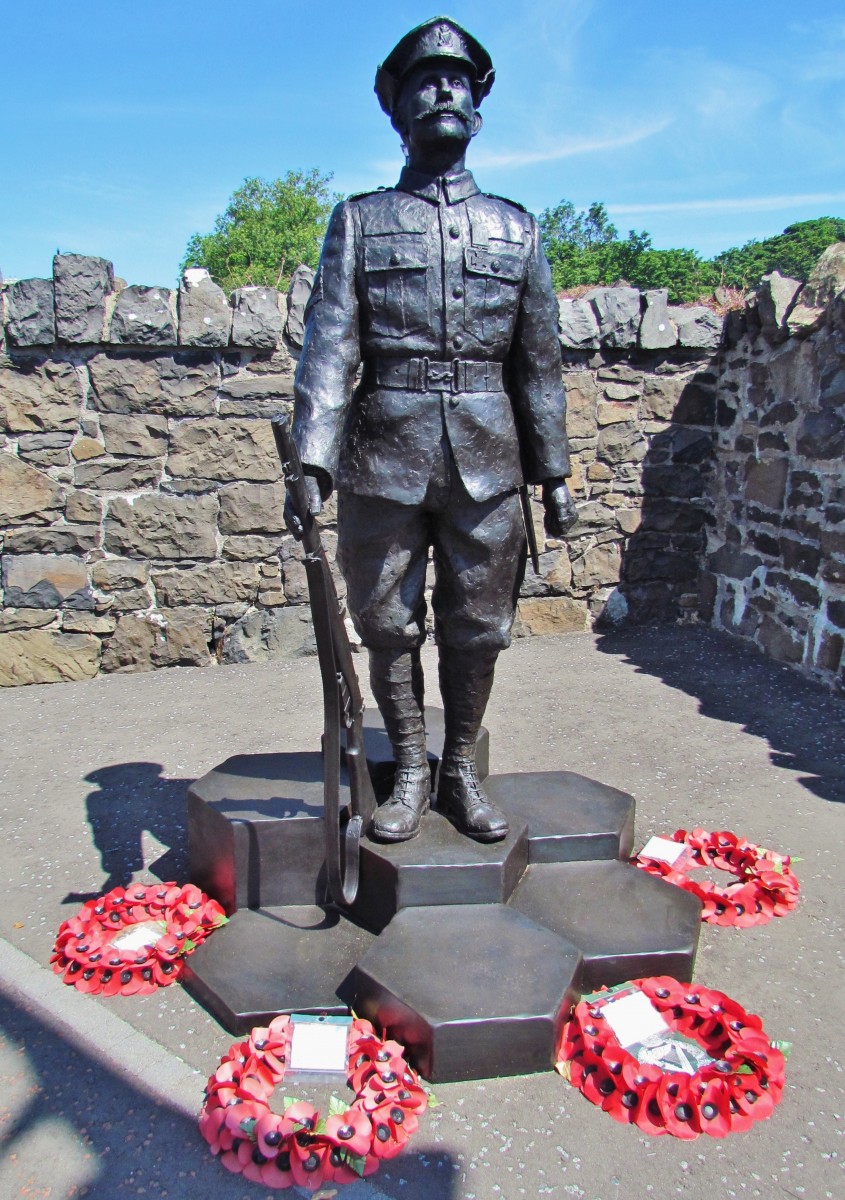Robert Quigg VC

|
| Private Robert Quigg VC |
 Robert Quigg was born in 1885 at Cornkirk, County Antrim near the Giant’s Causeway where, as a young man, he worked on the Macnaghten's estate. When Sir Edward Harry Macnaghten, aged 20, served with the 12th Battalion The Royal Irish Rifles as a Rifle Platoon Commander, Robert Quigg became his batman.
Robert Quigg was born in 1885 at Cornkirk, County Antrim near the Giant’s Causeway where, as a young man, he worked on the Macnaghten's estate. When Sir Edward Harry Macnaghten, aged 20, served with the 12th Battalion The Royal Irish Rifles as a Rifle Platoon Commander, Robert Quigg became his batman.
On the hot and sunny day that was the 1 July 1916, Private Quigg, with the rest of the platoon, advanced three times towards gaps in the German wire. However, each time the attack failed when the withering fire of German machine guns mowed down many of his friends. In the aftermath of battle, Quigg could not remain deaf to the cries and moans of his wounded friends lying in no man's land. He crawled from shell hole to shell hole seeking the wounded and dragging them back to British lines and medical aid.
 On the following day when it was clear that Sir Harry Macnaghten was missing, probably lying wounded in no man's land, Quigg again combed the blood-soaked mud. The German snipers, machine gunners and mortar teams had him targeted, never mind the many artillery shells that were landing round him. He calmly ignored all and evaded all as he crawled through the mud from shell hole to shell hole. He found, and carried or dragged back, wounded men on separate trips until, at nightfall on 2 July 1916, he was forced to give up when those left of his Battalion were ordered back from the trenches.
On the following day when it was clear that Sir Harry Macnaghten was missing, probably lying wounded in no man's land, Quigg again combed the blood-soaked mud. The German snipers, machine gunners and mortar teams had him targeted, never mind the many artillery shells that were landing round him. He calmly ignored all and evaded all as he crawled through the mud from shell hole to shell hole. He found, and carried or dragged back, wounded men on separate trips until, at nightfall on 2 July 1916, he was forced to give up when those left of his Battalion were ordered back from the trenches.
(Left, Rifleman Quigg's VC)
 For his brave actions Private Robert Quigg was awarded the Victoria Cross. His citation in the London Gazette’s Supplement dated 9 September 1916 read as follows:
For his brave actions Private Robert Quigg was awarded the Victoria Cross. His citation in the London Gazette’s Supplement dated 9 September 1916 read as follows:
No. 12/18645 Pte. Robert Quigg, R. Ir. Rif.
For most conspicuous bravery. He advanced
to the assault with his platoon three
times. Early next morning, hearing a
rumour that his platoon officer was lying out
wounded, he went out seven times to look
for him under heavy shell and machine gun
fire, each time bringing back a wounded
man. The last man he dragged in on a
waterproof sheet from within a few yards of
the enemy's wire.
He was seven hours engaged in this most
gallant work, and finally was so exhausted
that he had to give it up.
 Other regiments carried on the search of no-man's-land over the subsequent days and weeks as the battle raged around them. Sir Harry's body was never found. Today Sir Harry Macnaghten is remembered in Bushmills Church of Ireland, on the town war memorial, and on the Thiepval Memorial to the Missing of the Somme.
Other regiments carried on the search of no-man's-land over the subsequent days and weeks as the battle raged around them. Sir Harry's body was never found. Today Sir Harry Macnaghten is remembered in Bushmills Church of Ireland, on the town war memorial, and on the Thiepval Memorial to the Missing of the Somme.
HM The King presented Robert Quigg with his Victoria Cross on 8 January 1917, not at Buckingham Palace, but in the King's private residence, York Cottage, on the Sandringham Estate, Norfolk. Private Robert Quigg VC survived the war and went on to make the army his career. Following an off-duty injury in 1926, he was medically downgraded and continued his service at the RUR Depot in Armagh, retiring as a sergeant in 1934. He then worked in the barracks as a civilian, returning to Bushmills much later in life where he lived in a cottage on the Macnaghten estate. During the Coronation year (1953), he was introduced to HM The Queen when she visited Northern Ireland. Sergeant Robert Quigg VC died at the Dalriada Hospital in Ballycastle on 14 May 1955, aged 70. Sergeant Quigg was given a full military funeral and is buried in the Billy Parish Church of Ireland graveyard near Bushmills.
Above left; the memorial statue to Robert Quigg VC was erected in Bushmills village and unveiled by HM The Queen on 28 June 2016.
 Right, Robert Quigg's medals including the Russian Order of St George Medal (4th Class). The VC is not the original in this display.
Right, Robert Quigg's medals including the Russian Order of St George Medal (4th Class). The VC is not the original in this display.
(VC images subject to © control through RHQ R IRISH)





